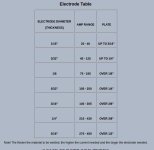Gary Fowler
Super Star Member
- Joined
- Jun 23, 2008
- Messages
- 11,998
- Location
- Bismarck Arkansas
- Tractor
- 2009 Kubota RTV 900, 2009 Kubota B26 TLB & 2010 model LS P7010
To the thinner of the components, yes rod size is needed to control heat input but for heavier sections, larger rods are only needed for production. You could easily weld up a 4" + thickness using a 3/32" rod if you didnt have to power to burn larger diameter, it would just take you many more hours to do it.View attachment 287786
These guidelines were taken from an old Miller SMAW training publication. Does the recommended amperage still apply to the new generation of inverter welders and is the rod chart still a reliable tool for selecting type and size? Also, is there any relationship between the diameter of the rod and the thickness of the metal being worked? TIA
Amperage to burn a welding rod is pretty much standard requirement whether using an old transformer style, gasoline powered or inverter powered machine as long as they are using the same current (AC or DC) I think DC requires less amperage that AC to run smoothly for the same size rod but I never use AC current since I got an AC/DC machine. I dont weld aluminum so AC is not needed presently at least in my shop. I also dont need high dollar MIG machine even though my power source would run one. I find I can do anything I need using SMAW process. If it gets too thin to use stick, I can always break out the oxy/acetylene torch and either braze it with brass or silver solder or oxy/acetylene weld it with carbon steel rods.

